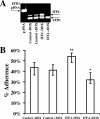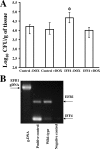Gene overexpression/suppression analysis of candidate virulence factors of Candida albicans
- PMID: 18178776
- PMCID: PMC2268510
- DOI: 10.1128/EC.00445-07
Gene overexpression/suppression analysis of candidate virulence factors of Candida albicans
Abstract
We developed a conditional overexpression/suppression genetic strategy in Candida albicans to enable simultaneous testing of gain or loss of function in order to identify new virulence factors. The strategy involved insertion of a strong, tetracycline-regulated promoter in front of the gene of interest. To validate the strategy, a library of genes encoding glycosylphosphatidylinositol (GPI)-anchored surface proteins was screened for virulence phenotypes in vitro. During the screening, overexpression of IFF4 was found to increase the adherence of C. albicans to plastic and to human epithelial cells, but not endothelial cells. Consistent with the in vitro results, IFF4 overexpression modestly increased the tissue fungal burden during murine vaginal candidiasis. In addition to the in vitro screening tests, IFF4 overexpression was found to increase C. albicans susceptibility to neutrophil-mediated killing. Furthermore, IFF4 overexpression decreased the severity of hematogenously disseminated candidiasis in normal mice, but not in neutropenic mice, again consistent with the in vitro phenotype. Overexpression of 12 other GPI proteins did not affect normal GPI protein cell surface accumulation, demonstrating that the overexpression strategy did not affect the cell capacity for making such proteins. These data indicate that the same gene can increase or decrease candidal virulence in distinct models of infection, emphasizing the importance of studying virulence genes in different anatomical contexts. Finally, these data validate the use of a conditional overexpression/suppression genetic strategy to identify candidal virulence factors.
Figures








References
-
- Alonso-Valle, H., O. Acha, J. D. Garcia-Palomo, C. Farinas-Alvarez, C. Fernandez-Mazarrasa, and M. C. Farinas. 2003. Candidemia in a tertiary care hospital: epidemiology and factors influencing mortality. Eur. J. Clin. Microbiol. Infect. Dis. 22254-257. - PubMed
-
- Andes, D., A. Lepak, A. Pitula, K. Marchillo, and J. Clark. 2005. A simple approach for estimating gene expression in Candida albicans directly from a systemic infection site. J. Infect. Dis. 192893-900. - PubMed
-
- Ausubel, F. M., R. Brent, R. E. Kingston, D. D. Moore, J. G. Seidman, J. A. Smith, and K. Struhl. 1994. Current protocols in molecular biology. John Wiley & Sons, Inc., New York, NY.
-
- Bain, J. M., C. Stubberfield, and N. A. Gow. 2001. Ura-status-dependent adhesion of Candida albicans mutants. FEMS Microbiol. Lett. 204323-328. - PubMed
Publication types
MeSH terms
Substances
Grants and funding
LinkOut - more resources
Full Text Sources
Other Literature Sources
Medical
Molecular Biology Databases

